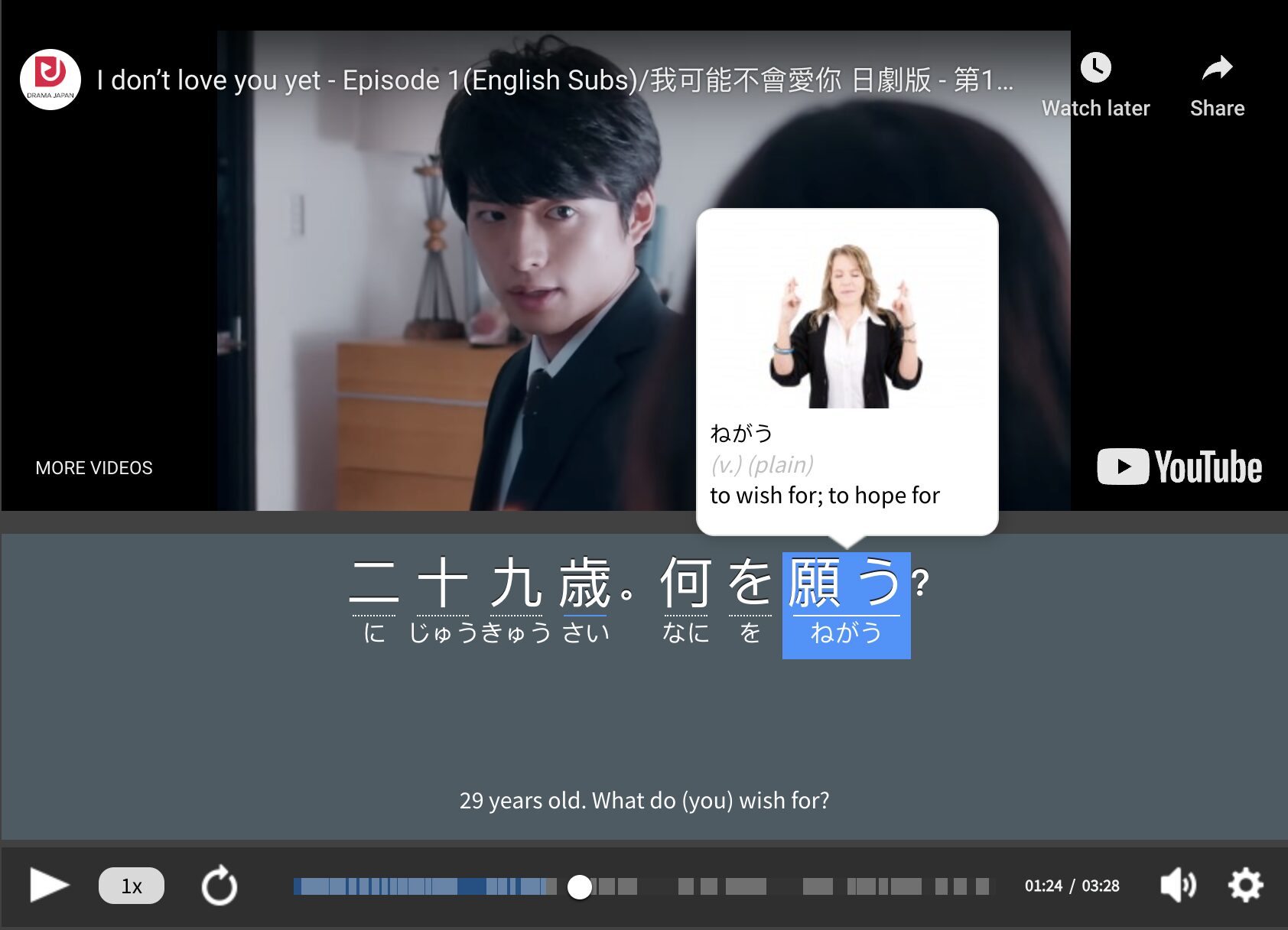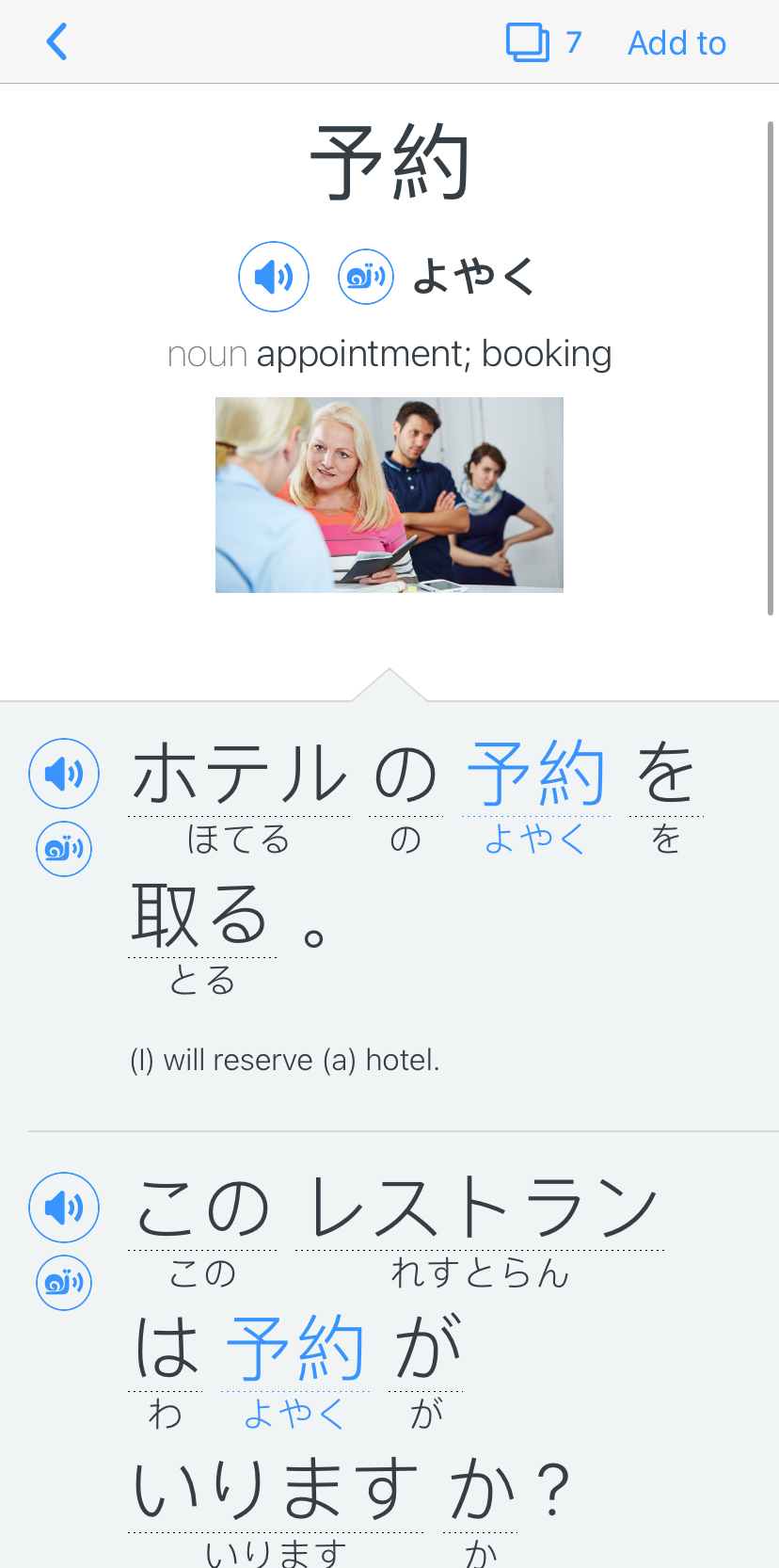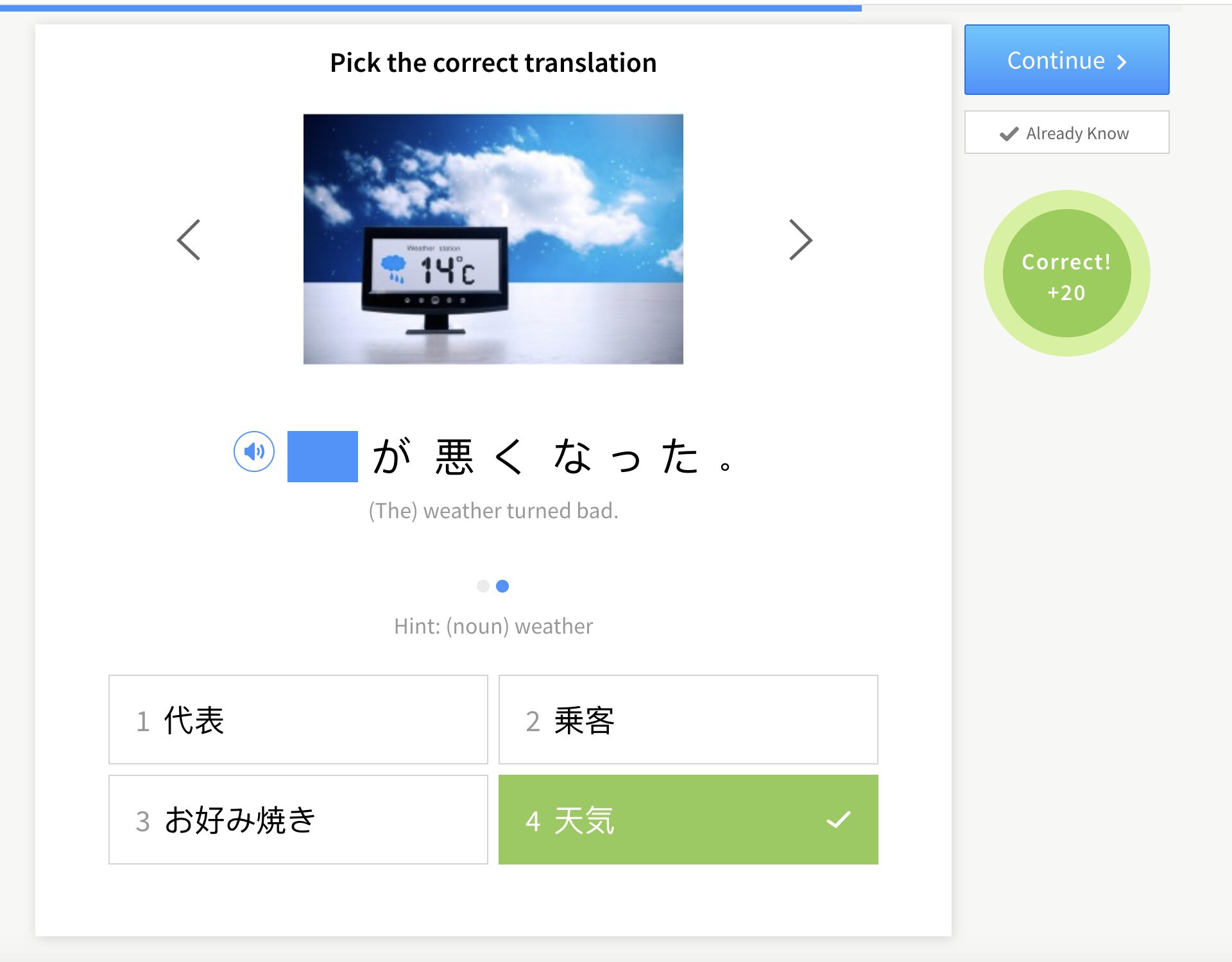Contents
- 1. Create a Schedule
- 2. Identify Problem Areas
- 3. Set Achievable Goals
- 4. Get a Paid Tutor
- 5. Group Vocabulary Words by Theme
- 6. Speak to Yourself in Japanese
- 7. Read Grammar Sites and Blogs
- 8. Mimic Your Favorite Character
- 9. Use Unscripted Media
- 10. Read Books You Love
- 11. Learn, Don’t Just Memorize Kanji
- 12. Remember Why You’re Learning Japanese
- And One More Thing…
How to Improve Your Japanese Skills in 12 Steps

I’ve been studying Japanese for over 10 years and I’ve learned a lot about learning over that time. To master Japanese, you’ll need structure and practical strategies, and you’ll find both in this guide. I’ll teach you how to create an effective study schedule and how to improve your Japanese listening, reading, writing and speaking skills using tips and methods that worked for me over the years.
Download: This blog post is available as a convenient and portable PDF that you can take anywhere. Click here to get a copy. (Download)
1. Create a Schedule
I once joined a photography group online to try and rekindle my love for the art. For weeks, I struggled to find the time to take photos, while others in my group seemed to be having no trouble at all, despite also being parents and having jobs. When I asked how they find time to take photos in their busy schedules, one person’s response opened up my mind: “I don’t find time. I make time.”
If you keep looking for moments in your schedule to magically open up so you can sneak some Japanese learning in, you won’t get very far. Create a schedule and stick to it—consistency, not perfection, is the key to success. Your schedule should work with your goals and the time you have available. Don’t push yourself so hard that you won’t be able to maintain your routine, but do push enough to actually move forward in your studies.
Remember, also, that a schedule doesn’t always look the same for everyone. Someone might be able to study at a specific time every day. I’m a mother and my days are often hectic and disorganized, so a more flexible scheduling system works better for me. Here are some forms of scheduling you can try to help remain on track with your learning schedule:
- Time blocking: Divide your day into distinct time frames, or “blocks,” dedicated to specific tasks. For example, you might create a one-hour block for Japanese learning on Tuesday evenings.
- Swallowing the frog: This method comes from the author Mark Twain, who said that if you eat a live frog in the morning, you can enjoy the rest of your day knowing that you’ve already done the hardest thing for that day. Under this scheduling method, make learning Japanese your topmost priority for a day or two a week, and focus on it before you can tackle any other tasks.
- The Pomodoro method: If you struggle with staying focused once you start learning, this method can keep you on task. It works by having you focus on one thing for 25 minutes, followed by a five-minute rest. After a set number of focus sessions, take a longer break (10-15 minutes).
There are plenty of other methods, but the three above are my favorites. Find the one that works for you!
2. Identify Problem Areas
If you’re learning on your own, you need to have a plan. The best thing about self-studying is that what and how you learn are completely personalized to you. But before you can dive into learning, you’ll need to identify what you need to learn. There are several levels to this self-analysis, and I recommend doing all of them for the best eventual results:
- Determine your JLPT level. Even if you have no plans to take the official Japanese language test, finding out what level you’re at can help you find appropriate learning materials. This page from Teachable has excellent sample tests for each level.
- Determine what you haven’t been studying. This seems self-evident but for a well-rounded learning experience, you need to tackle every area of language learning. Speaking, in particular, often falls by the wayside when you’re studying. Check your learning: Are you improving reading, speaking, writing, listening, vocabulary and grammar? I like to have a different app for each language skill to make sure I’m hitting them all in my studies.
- Determine holes in your knowledge. This is an ongoing task, as you’ll be constantly identifying gaps in your learning. For instance, when I visited Japan I kept failing to understand when the cashiers asked me if I needed a bag. Clearly, there was a gap in my vocabulary, so I learned the different ways to say “bag” in Japanese so I’d know it when I heard it.
As you study, you’ll be constantly identifying new areas that need improvement. I highly recommend keeping a language journal and tracking what you study in it. Make a note of language elements you feel you’ve mastered in one color and ones you feel you need to target in another. This way, when you look back in your journal, you’ll know what to review.
3. Set Achievable Goals
I make lists for everything, including my goals and plans. I learned a long time ago that if my goals are too vague, like “study more Japanese,” I won’t be able to keep them. There are many goal-making methods, but the one I’ve found the most useful is SMART goals. SMART stands for “Specific, Measurable, Achievable, Relevant and Timely.” It helps you to break down your goals into goals you can actually meet.
Let’s break down my “study more Japanese” goal into a SMART goal:
- Specific: Learn 40 new vocabulary words in a month.
- Measurable: I prepared a test featuring all 40 words I want to learn, which I can take at the end of the month.
- Achievable: I can learn 10 words per week in 15-20 minute intervals in the mornings using the “eat the frog” method.
- Relevant: The words I picked are specific to restaurants because there’s a particular Japanese restaurant I want to visit at the end of the month.
- Timely: I made a reservation for next month at the restaurant so I have a tangible time limit.
The above is just an example! Your goals will probably look very different, and that’s perfectly fine—everyone’s learning journey is different.
It’s also important to note that your goals are not set in stone. Good goals are flexible. You should periodically check your goals, track your progress and adjust as needed. For instance, I might find that I have a lot more time on my hands, so I can learn 15 words per week instead of 10. In this case, I’d adjust the other parts of my goals accordingly.
If SMART goals are too involved for you, just remember this: Good goals are specific, and broad goals should be broken down into smaller tasks.
4. Get a Paid Tutor
Learning by yourself is effective—up to a point. Many learners eventually hit a wall where they just don’t seem to be able to progress any further. This usually happens at the intermediate level, and is so common that it’s known as the “intermediate plateau.” If you find yourself feeling stuck, that might mean it’s time to find a tutor to help you move forward. Of course, you can get a tutor much earlier (or later) in your language-learning journey. I personally found it useful to start with a teacher from the very beginning, to ensure that I learned the right foundation in the language.
Regardless of when you get your tutor, it’s important for them to be a paid teacher. In a time when a lot of resources are available online for free, this may seem like strange advice. There are two key reasons why you should shell out for a paid tutor:
- Paid tutors are professionals, so they know what they’re doing and can help you better than someone who’s just volunteering their time.
- When you pay money for something, your sense of its value increases and you’re more likely to actually use it.
Take me as an example: I was exercising on and off for months, sometimes doing one or two days a week and other times skipping entire weeks. Once I signed up for a paid virtual personal trainer, I started working out regularly three times a week. It turns out that it’s incredibly motivating to know that someone is holding you accountable, and to know that if you don’t use their service you’re wasting your money.
There are plenty of virtual tutoring services where you can find a great Japanese teacher. Here are a few to start your search:
- Kakehashi Japan offers Skype lessons with various focuses, including JLPT prep, conversation, vocab and culture. They also offer free trials for new students.
- italki is a popular tutoring service with hundreds of high-quality teachers. You can search for a tutor by gender, price, availability and even location, in case you’re interested in a regional form of Japanese.
5. Group Vocabulary Words by Theme
I once tried to memorize some words on a frequency list. I think I managed to remember about three from a list of 20. The problem was that they were all completely disconnected and grouped arbitrarily. On the other hand, I can still perfectly remember how to introduce myself in Japanese, even though it was the very first thing we learned in Japanese class way back in college, years ago. That’s because all those words and phrases are grouped together in one category in my mind: introductions.
Try to group new vocabulary words by topics like food, travel, daily activities, seasons, etc. A lot of apps are already organized this way, so you can get a head start by downloading a Japanese vocabulary app. I also recommend adding new words to your favorite flashcard app like Anki, even if you’re already learning the words in an app. This way, you can review your vocabulary whenever you need but you can also add words that you feel are missing. For example, the word for “bag” might not be considered a typical “travel vocabulary” word, but clearly I needed to know it in my travels.
You don’t have to rely on flashcards alone to learn your new words. If you’re a visual learner, create a mind map to visually organize your words. Here’s an example for English words related to food, to give you an idea of what this might look like. You can also incorporate your themed vocab into journal writing or use them in conversation with your tutor or speaking partner.
6. Speak to Yourself in Japanese
Getting a language exchange partner is an amazing way to practice Japanese with a native speaker. But I’ll be the first to admit that it’s not for everyone! I have a job and a family, and I’m an introvert—all of which tend to get in the way of my efforts to coordinate with another human being (especially if I’m not paying them for their time).
You know who’s always available to practice with me? I am. You are your own best language partner, since you’re always there to listen and you don’t care if what you’re talking about is boring. Here are some ideas to get you started:
- Narrate your daily activities. For example, if you’re cooking breakfast, describe what you’re doing in detail, like this: “I am cooking breakfast. I crack an egg. I put the pan on the fire.”
- Describe your surroundings. For example, if you’re in a park, talk about what else is there, what plants and animals you see, the other people there with you, the color of the leaves, etc.
- Roleplay scenarios. For example, you can pretend that you’re ordering your favorite drink at a Japanese cafe, buying a book, meeting someone new for the first time, etc.
One downside to speaking with yourself is that you don’t have immediate feedback from a native speaker. There are some things you can do to make up for this. One of the best is to record yourself speaking out loud. Once you have a recording, you can refer back to it to see what vocabulary words you’re missing or unsure of, to work on your grammar and sentence structure and even to share it with a native speaker for that much-needed feedback.
7. Read Grammar Sites and Blogs
Grammar is difficult to master in any language. Luckily, there are many grammar websites, blogs and resources online for Japanese learners. There are, of course, plenty of Japanese grammar textbooks, too. These textbooks are valuable resources, but the reason I love websites, in particular, is because they tend to be more “human.” Many online resources make the grammar points accessible for learners and easier to understand.
Here are some of my favorites:
- Maggie Sensei is run by popular Japanese culture video blogger Victor “Gimmeabreakman” and his friend Yukari, who writes the content for the site. It’s a great resource for learning Japanese grammar as it’s commonly used in conversation through easy-to-digest posts.
- Tae-Kim’s Guide to Learning Japanese is one of the original and most well-known free Japanese grammar and study resources on the net. Tae-Kim now has mobile apps available for study, as well.
- Imabi has an impressively comprehensive collection of grammar lessons, perfectly organized and clearly explained. This is one resource you’ll want to bookmark and return to again and again.
- FluentU Japanese Blog is where you are right now. And you’re having a good time, right? I hope so! Run through our grammar and vocabulary posts to learn the ins and outs of Japanese.
You can read through the lessons and blogs one by one, in order, or search for specific grammar points that you want to study. Many websites have additional resources like apps, YouTube channels and newsletters.
8. Mimic Your Favorite Character
A few years ago, my husband was playing an “Atelier” game with the Japanese voice acting on. I wasn’t paying attention, but it was on in the background, and before long I was yelling たる (taru) and 錬金術 (renkinjutsu) every time I heard it, with the same intonation as the characters. It’s not very useful to know the Japanese words for “barrel” and “alchemy” (though I guess you never know…), but to this day, years later, I remember both words. Here’s how you can apply this to your own studies:
- Choose the media you’ll be using. You can use anything, from TV shows and movies to games and YouTubers. Whatever you choose, make sure that you have easy access to them speaking. For instance, if you want to use a game, find a good recording of key moments, so you can replay lines as needed. You’ll also need to choose something that’s relevant to your learning so you don’t end up with useless words like I did.
- Choose a character. This should be a character that you can identify with in a show you really like. The character might be your own gender, have a similar profession or express a similar outlook on life with their spoken words. Try to pick someone who speaks the way you’d ideally like to speak in Japanese.
- Listen to some clips. Track down some clips of that character speaking naturally. Try to find something that isn’t too crazy or emotional. Just find them talking normally.
- Record yourself copying them. Repeat that same dialogue a few times and try shadowing them as they speak. Then give it a go one more time while recording yourself. Make sure you try to match the intonation and stress exactly.
- Compare your recording to the original clip. Find points that you need to improve on and keep trying.
There’s a lot to learn from each line you use, so pay close attention:
- Is the situation formal? Casual? How does the language differ in each situation? What words are they using?
- Look at how vocab words are used. For example, even though they have words for “say” and “tell,” Japanese people use the verb for “to teach,” 教える (oshieru), when saying “someone told me something.”
- Pay attention to words and patterns used more commonly by one gender over the other. For example, younger Japanese women tend to use the ~なの (-nano) ending to questions in familiar situations. Men tend not to use this. Women also sometimes end their sentences with わ (wa) to soften them. Men occasionally do this, but not nearly as often.
- Make note of any strange expressions that don’t seem to make any sense in context. It’s probably an idiomatic expression. One of my favorite in Japanese is 頭に来る (atama ni kuru) or “coming to my head.” This means to get very angry. It makes no sense reading it literally, right?
The best resource for this activity is one that has clear and accurate subtitles, like FluentU.
FluentU takes authentic videos—like music videos, movie trailers, news and inspiring talks—and turns them into personalized language learning lessons.
You can try FluentU for free for 2 weeks. Check out the website or download the iOS app or Android app.
P.S. Click here to take advantage of our current sale! (Expires at the end of this month.)

9. Use Unscripted Media
While I didn’t start out learning Japanese because I loved anime, I started to love anime as I learned Japanese. But after years of watching shows, I was starting to become frustrated. No matter how much I studied, I just couldn’t seem to be able to understand much beyond the basics. Then, one day, I watched a Japanese YouTuber’s vlog and realized that I understood a large part of it. I’ve seen this written so many times but it never quite sank in: Anime is not always a good example of real Japanese.
Any scripted media is, by its nature, stilted. You can learn a lot from TV shows and movies, and I absolutely recommend it. However, it’s equally important to hear natural Japanese. Once I started to mix up my Japanese media intake, I started to understand more and more. And, when I visited Japan, I realized that I could keep up with much of what was said to me! I already had the building blocks in place, I just had to learn to apply them to the right content.
Here are some of my favorite authentic Japanese media sources on YouTube:
- Minori: A sweet YouTuber who makes art and crafts, does Japanese crane games and makes videos on all sorts of cute things. She also has English-language content, and it’s really interesting to see how her speech, mannerisms and even content differ between the videos she makes for Japanese audiences and those she makes for English speakers.
- Masaru: If you’re not a fan of seafood, you may want to look away. This young biologist catches, prepares and eats many different kinds of fish, even the ones reputed to be poisonous, inedible or just plain stinky!
- Ryoya Takashima: Ryoya makes a huge variety of videos, from laid-back travel vlogs, to plant-based cooking, tech reviews and photography. He speaks very slowly and clearly, so he’s incredibly easy to follow, even when he’s talking about something I don’t know much about, like the latest innovations in drones.
10. Read Books You Love
Reading in Japanese isn’t easy (I know, it’s a huge revelation). Whenever I tried to practice my reading skills, I found my mind wandering and rebelling against being forced to work so hard. There are only two things that have helped me to read: necessity and desire. When I visited Japan, I was reading everything because I had to. I needed to know where to go and what products were and other necessary things. But traveling to Japan isn’t in everyone’s future (or budget), so the next best thing is the second option: reading because you love it.
The real trick is to find something that you love that’s also at your learning level. This means that, as much as I’d love to read a Haruki Murakami novel in its original Japanese, I’m just not ready for that. Instead, I’ll settle for simpler texts that I still love, including light novels like ビブリア古書堂の事件手帖 (“Biblia Antique Bookstore’s Case Files”) and manga like スパイファミリー (“Spy x Family”). If you’re a beginner, you might have to start with simple children’s books, but that doesn’t mean you can’t enjoy what you read. Japan has some of the weirdest and most delightful children’s books, so you can easily find something to love at any level.
If you’re not sure where to start, here are the strategies I’ve used when reading authentic Japanese text:
- Buy a physical copy of your book. If you’re the kind of person who hates marking up books, skip this one! Owning a copy lets me highlight words I don’t know, write translations for entire sentences, underline sentences I find interesting and so on.
- Translate what you read. You might be able to understand what you’re reading, but translating forces you to slow down and look at every single word and sentence structure.
- Read and summarize. This is one of the best ways to tell if you understood the text. Get a bonus learning boost by writing or speaking your summaries in Japanese!
- Find the English translation. Have it on hand to check your reading and make sure you’re getting everything right. If you don’t have access to an English version, an app like Google Lens works in a pinch.
11. Learn, Don’t Just Memorize Kanji
Read this word out loud: “Though.” Now read this one: “Through.” Both words are practically the same with only one letter difference, but you read them differently. How do you know when to read “ough” as “ow” or “ooh”? If your answer is a big shrug, then you’re ready to study kanji. The delightful PonPon Sensei has a short video that explains this idea more in-depth.
Many websites teach kanji out of context, by presenting you with lists or introducing the characters in isolation and showing you the different ways to read them. Imagine how that would look in English (see my “ough” example) and you’ll begin to understand why this is not an effective way to study kanji. Instead, learn kanji as you learn Japanese: Every time you learn a new word in Japanese, learn its kanji. That’s it!
It sounds simple because it is, but that doesn’t mean there’s no effort involved. I recommend keeping a notebook (physical or digital) where you keep a running list of new kanji that you read. Make a new page for every kanji that you come across. Every time you learn a new word that uses the kani, add it to that character’s page, noting its reading and the sentence or context where you first learned it. This will help you build your kanji knowledge organically, building on previous knowledge and introducing new readings in a more memorable way than just reading a list.
12. Remember Why You’re Learning Japanese
One aspect of language learning that isn’t talked about too commonly is motivation. Learning a new language is a difficult endeavor and it can be easy to lose motivation over time. My own motivation comes in spurts, with studies often interrupted by life. Whenever I find myself winding down, I try to remember why I’m studying Japanese in the first place. I’ve always loved the language and culture and I hope to visit the country many more times in my life. I want to be able to communicate with Japanese speakers on my trips and meet many wonderful people across many beautiful places.
Your reason for learning Japanese will likely look different from mine. Have you always wanted to be able to watch anime without subtitles? Great! Give your Japanese learning a little kick-start by taking the time to watch your favorite anime shows every day. Incorporate what you love into your learning and make it fun again. Find your motivation by remembering why you started this language-learning journey in the first place.
You’re ready to take the next steps and improve your Japanese. I hope my tips help you move forward in your learning journey!
And One More Thing…
If you’re like me and prefer learning Japanese on your own time, from the comfort of your smart device, I’ve got something you’ll love.
With FluentU’s Chrome Extension, you can turn any YouTube or Netflix video with subtitles into an interactive language lesson. That means you can learn Japanese from real-world content, just as native speakers actually use it.
You can even import your favorite YouTube videos into your FluentU account. If you’re not sure where to start, check out our curated library of videos that are handpicked for beginners and intermediate learners, as you can see here:
FluentU brings native Japanese videos within reach. With interactive captions, you can hover over any word to see its meaning along with an image, audio pronunciation, and grammatical information.
Click on a word to see more examples where it's used in different contexts. Plus, you can add new words to your flaschards! For example, if I tap on 予約, this is what pops up:
Want to make sure you remember what you've learned? We’ve got you covered. Each video comes with exercises to review and reinforce key vocab. You’ll get extra practice with tricky words and be reminded when it’s time to review so nothing slips through the cracks.
The best part? FluentU tracks everything you’re learning and uses that to create a personalized experience just for you. Start using the FluentU website on your computer or tablet or, better yet, download our app from the App Store or Google Play.
Click here to take advantage of our current sale! (Expires at the end of this month.)











